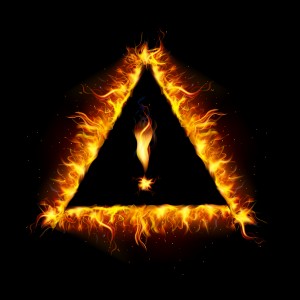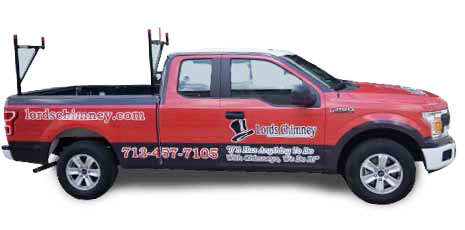
Look closely and pay attention to the signs that say your firebox needs a replacement.
Before we talk about firebox replacement , let’s get into what a firebox is. When you stack up your wood and build your fire in your fireplace, the area that’s holding that fire — fittingly, shaped a lot like a box — is what we refer to as the firebox.
Whether you have a masonry or factory-built fireplace, that firebox was made with materials that were designed to hold up to years of high heat (and since the firebox really does bear the brunt of the heat of your fire, they need to be built that way). Masonry fireboxes are constructed out of firebrick, and those firebricks are made with a refractory material that’s highly resilient when exposed to extreme temperatures. Factory-built or prefabricated fireplaces are largely built out of metal, but the firebox itself is bolstered by refractory panels on the bottom and sides — which also offer that durability and strength when faced with the high temperatures of repeated fires.
Why Would I Need To Replace A Firebox?
As strong as fireboxes are designed to be, over time, it’s not unusual for damage to occur. The type of damage will differ, depending on your individual use, circumstances, the firebox’s construction and other factors, but we see a few common problems.
Masonry fireboxes
Sometimes masonry fireboxes weren’t built correctly (with older ones, it’s not uncommon to see non-refractory mortar that just isn’t equipped to last under that abuse). Sometimes leaky chimneys allow water to get into the firebox, and as moisture combines with creosote, acids start to wear at the masonry — particularly the joints. If the damage is serious, you may notice it as you go to build a fire. But more likely, it’ll take professional eyes to see a problem in your firebox — and firebox problems can quickly become fire hazards, so that underlines why annual chimney inspections are so important.
Factory-built fireboxes
Most often, firebox refractory panels just begin to wear and abrade, and cracks start to develop either in the panel itself or around the joints between panels. A good rule of thumb is generally to seek repairs or replacement when cracks reach the thickness of a nickel.
The repair approach will depend, too, on the individual circumstances of the firebox and its damage, and Lords Chimney technicians will fully inspect yours to recommend the best course of action. Sometimes refractory panels can be replaced to repair a factory-built firebox. Sometimes the firebox has reached the end of its service life, and the unit needs to be replaced. We may be able to repair damaged mortar joints in a masonry firebox, or it may need to be rebuilt. But rest assured, when you have Lords Chimney come out to take care of your firebox problem, your fireplace will get the attention it needs, and you’ll get back the heating appliance you love, returned to the levels of performance and safety you expect.
If you have any questions about fireboxes — or your firebox, specifically — we’re always here to help. Just give Lords Chimney a call!

Ever wondered how some fires die out in an instant while others burn for a long time? It has something to do with combustion. Read on to learn more about it.
Everything You Need to Know About Creosote
What is Creosote?
Creosote is a chemical byproduct that is produced after the distillation of tar. So when wood is burned, creosote is produced. It is known for its preservative properties and for being anti-septic. There are basically two types of creosote; the wood-tar, and the coal-tar. The wood-tar creosote, being less toxic, is commonly used in meat preservation, wood treatment and for medicinal purposes. When used medicinally, it is commonly utilized as an astringent, anesthetic, expectorant, laxative and anti-septic. The coal-tar creosote is more commonly used in wood preservation because of its toxic properties.

In its early stages of accumulation, creosote is flaky. As it left to build…it becomes more tar-like. All creosote is highly flammable.
Creosote in Chimney
There are several stages that the creosote in your chimney that you may experience. First is its’ soot: a flaky form that is easy to remove leaving the flue walls unobstructed. Second: the stage where it leaves brittle and hard deposits that are a bit more difficult to remove. The third is the glazed stage where it becomes dangerous and much more difficult to remove. Once you notice the dense, dark and shiny tar-like appearance, then this would indicate that the creosote has reached its glazed stage. There will always be some level of creosote in your chimney – as it is a natural byproduct of burning, but it doesn’t need to be left to accumulate.
Possible Dangers
The longer creosote is ignored…the greater the possible danger. Creosote is highly flammable and is a leading cause of chimney fires. You may see products, such as a log that is supposed to remove creosote while burning. Not only is this difficult to gauge in its effectiveness, it may also cause chunks of creosote to fall down your flue and get stuck along the way. Because of the fire risk, you should leave creosote removal to a professional.
Preventive Measures
To avoid higher risk for a catastrophe, don’t wait for your chimney to reach a disastrous level of creosote build-up. It is best to schedule regular chimney inspections and sweeping on an annual basis. This way you know you are not letting the buildup become a hazard. This also prolongs your chimney’s lifespan.
We hope that this has been helpful and sufficient in answering your questions about creosote. So now you are fully equipped with the knowledge to better protect and improve your home. If you have a chimney, make sure to have it checked regularly and make it a habit to schedule a regular inspection and sweeping by a chimney professional.
The Damaging Effects of Water in Your Chimney
There are so many different things that can go wrong with a chimney when it is not maintained properly. With all of the things that homeowners have to worry about, water entering the chimney is often not at the top of the list. However, it is important for all homeowners with chimneys to realize just how dangerous it can be if they have an excessive amount of water building up inside of the flue. Although it seems like an unlikely issue, it is easy for water to enter a chimney in the form of rain or snow.

When moisture gets into your masonry, you will see deterioration. Do all that you can to divert water from the chimney.
One of the most dangerous problems that can arise from water in the chimney is the growth of mold. When mold grows in the chimney, it is only a matter of time before it spreads throughout the foundation of the home. When it is inhaled by people living in the home, they are at risk for serious respiratory ailments that have, on occasion, been known to be fatal. In some cases, the mold will produce a smell but, in others, it may be impossible to tell that there is an issue until someone becomes ill.
Most chimneys are made of brick and many have liners that are constructed out of clay or tile. When water builds up and sits in the chimney, it can slowly deteriorate these fragile materials. This can compromise the entire structural integrity of the chimney and make it an extremely dangerous thing to have on the home. As it weakens, it will be able to withstand much less in terms of extreme weather and the heat that it endures during a fireplace fire.
Whenever there is stagnant water in a space, there is a chance that it will start to become a home for a variety of bugs. When this happens in a chimney, it is only a matter of time before those bugs make their way into the home. In the best cases, this is simply annoying and can be taken care of with some bug spray. However, in other cases, the bugs will carry diseases and can cause everyone in the home to become terribly sick.
Unfortunately, it can be difficult for homeowners to know whether they have a problem with water in their chimneys. This is why it is so important to have an annual inspection with a certified chimney inspector. They will be able to quickly identify any problems that are in place as the result of water in the chimney. More importantly, they will be able to recommend possible remedies that will correct the situation as quickly as possible.
The best way to avoid problems with water in the chimney is by installing a chimney cap. This simple little piece of material can keep water out of the chimney, as well as animals and other natural debris. All of these things pose a risk to the people in the home and compromise the function of the chimney. It is a simple and inexpensive precaution that can help prevent a great deal of serious problems down the line.
Water in the chimney may not seem like a big problem but, if left unattended, it can actually cause some very serious issues. A chimney with standing water will quickly become a home for bugs and the perfect place for mold to grow. In addition, it can make the entire structure weak and, therefore, dangerous. An annual inspection is the best way to make sure that there are no major issues with water in the flue.





